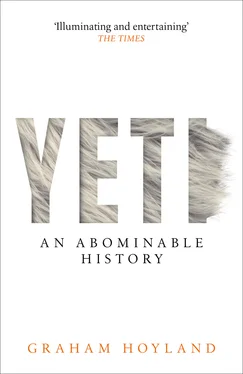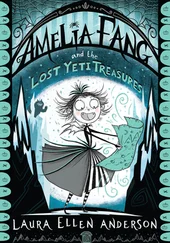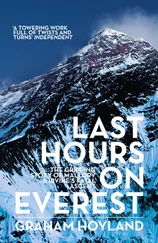Superstition, however, knows no logic, and my explanation produced no effect whatsoever on Wangdi.
At length, having taken all the photographs I wanted on the pass, I asked the men to accompany me and follow up the tracks. They were very averse to this at first, but eventually agreed, as they said, following their own ‘logic’, that the Snowman had come from, not gone, in that direction. From the pass the tracks followed a broad, slightly ascending snow-ridge and, except for one divergence, took an almost straight line. After some 300 yards they turned off the ridge and descended a steep rock-face fully 1,000 feet high seamed with snow gullies. Through my monocular glass I was able to follow them down to a small but considerably crevassed glacier, descending towards the Bhyundar valley and down this to the lowermost limit of the new snow. I was much impressed by the difficulties overcome and the intelligence displayed in overcoming them. In order to descend the face, the beast had made a series of intricate traverses and had zigzagged down a series of ridges and gullies. His track down the glacier was masterly, and from our perch I could see every detail and how cunningly he had avoided concealed snow-covered crevasses. An expert mountaineer could not have made a better route and to have accomplished it without an ice-axe would have been both difficult and dangerous, whilst the unroped descent of a crevassed snow-covered glacier must be accounted as unjustifiable. Obviously the ‘Snowman’ was well qualified for membership of the Himalayan Club.
My examination in this direction completed, we returned to the pass, and I decided to follow the track in the reverse direction. The man, however, said that this was the direction in which the Snowman was going, and if we overtook him, and even so much as set eyes upon him, we should all drop dead in our tracks, or come to an otherwise bad end. They were so scared at the prospect that I felt it was unfair to force them to accompany me, though I believe that Wangdi, at least, would have done so had I asked him.
The tracks, to begin with, traversed along the side of a rough rock-ridge below the minor point we had ascended when we first visited the pass. I followed them for a short distance along the snow to one side of the rocks, then they turned upwards into the mouth of a small cave under some slabs. I was puzzled to account for the fact that, whereas tracks appeared to come out of the cave, there were none going into it. I had already proved to my own satisfaction the absurdity of the porters’ contention that the Snowman walked with his toes behind him; still, I was now alone and cut off from sight of the porters by a mist that had suddenly formed, and I could not altogether repress a ridiculous feeling that perhaps they were right after all; such is the power of superstition high up in the lonely Himalayas. I am ashamed to admit that I stood at a distance from the cave and threw a lump of rock into it before venturing further. Nothing happened, so I went up to the mouth of the cave and looked inside; naturally there was nothing there. I then saw that the single track was explained by the beast having climbed down a steep rock and jumped into the snow at the mouth of the cave. I lost the track among the rocks, so climbed up to the little summit we had previously visited. The mist was now dense and I waited fully a quarter of an hour for it to clear. It was a curious experience seated there with no other human being within sight, and some queer thoughts passed through my mind. Was there really a Snowman? If so, would I encounter him? If I did, an ice-axe would be a poor substitute for a rifle, but Wangdi had said that even to see a Snowman was to die. Evidently he killed you by some miraculous hypnotism; then presumably gobbled you up. It was a fairy-tale come to life … Meditating on this strange affair, I returned to the porters, who were unfeignedly glad to see me, for they had assumed that I was walking to my death.
This, the classic sighting of bear tracks masquerading as yeti prints, is worth deconstructing. All the usual features are present: the shock of the initial sighting, the puzzlement, the backwards-facing feet, the fear of the Sherpas and the curiosity of the Sahib. As John Napier explains in his seminal study Bigfoot: The Yeti and Sasquatch in Myth and Reality , 11bears are a good candidate for the makers of yeti footprints for several reasons. First, like humans, bears are plantigrade; that is, the anatomy of their walking leg is such that the sole of the foot takes the weight. Their toes and metatarsals are flat on the ground. So they make footprints that look like those of a huge human (or yeti). The other options are digitigrade, walking on the toes with the heel and wrist permanently raised, like dogs and cats, and unguligrade, walking on the nail or nails of the toes (what we call the hoof) with the heel/wrist and the digits permanently raised. So horses are running on their toenails.
Secondly, when bears are walking slowly their hindfeet land just behind the impression made by their forefeet, and when they are walking fast their hindfeet land just beyond the impression of the forefeet. And – here’s the important bit – at an intermediate speed the two footprints join together, sometimes with the toes of the forefeet appearing to be … reversed toes. To make this clear, the oft-repeated story of toes at the rear of the yeti footprint could be explained by medium-speed bears.
At an amble, the bear footprints follow one another more in a line, rather like those of a fashion model on a catwalk (well, a bit like that). This just might explain the footprints in a line seen by some witnesses. But there is another possible explanation for those linear sightings. Bears can also walk on their hindlegs for short distances and will stand on their hindlegs to fight with the claws on their front paws, to reach fruit from high branches, or to climb trees. These behaviours will result in human-looking bipedal footprints.
As for the ‘elephant’ footprints noted later by Shipton et al., when overnight temperatures are low an icy crust forms on the snow. This icy crust is 2 to 3 inches deep and can support the weight of a man. Mountaineers know this, so they get up just after midnight for an ‘Alpine start’ and move fast across the surface of the snow. Your crampons barely scratch the snow and it is a delight to climb at this time of the morning and watch the sun rise on the peaks around you. Later in the day, the crust melts and gives way when walked on, to the despair of the knackered climber, whose every step now plunges deep into the snow. At either side of the footprint, a roughly triangular area of snow caves in and the resulting shape is rhomboidal. If melting is now added, gigantic elephant-like tracks are the result.
Let’s get back to Frank Smythe:
On returning to the base camp some days later, the porters made a statement. It was witnessed by Oliver and runs as follows:
‘We, Wangdi Nurbu, Nurbu Bhotia and Pasang Urgen, porters employed by Mr F. S. Smythe, were accompanying Mr Smythe on July 17th over a glacier pass north of the Bhyundar Valley when we saw on the pass tracks which we knew to be those of a Mirka or jungli Admi (wild man). We have often seen bear, snow leopard and other animal tracks, but we swear that these tracks were none of these, but were the tracks of a Mirka.
‘We told Mr Smythe that these were the tracks of a Mirka and we saw him take photographs and make measurements. We have never seen a Mirka because anyone who sees one dies or is killed, but there are pictures of the tracks, which are the same as we have seen, in Tibetan monasteries.’
My photographs were developed by Kodak Ltd of Bombay under conditions that precluded any subsequent accusation of faking and, together with my measurements and observations, were sent to my literary agent, Mr Leonard P. Moore, who was instrumental in having them examined by Professor Julian Huxley, Secretary of the Zoological Society, Mr Martin A. G. Hinton, Keeper of Zoology at the Natural History Museum, and Mr R. I. Pocock. The conclusion reached by these experts was that the tracks were made by a bear. At first, due to a misunderstanding as to the exact locality in which the tracks had been seen, the bear was said to be Ursus arctos pruinosus , but subsequently it was decided that it was Ursus arctos isabellinus, which is distributed throughout the western and central Himalayas. The tracks agreed in size and character with that animal and there is no reason to suppose that they could have been made by anything else. This bear sometimes grows as large as, or larger than, a grizzly, and there is a well-grown specimen in the Natural History Museum. It also varies in colour from brown to silver-grey.
Читать дальше











